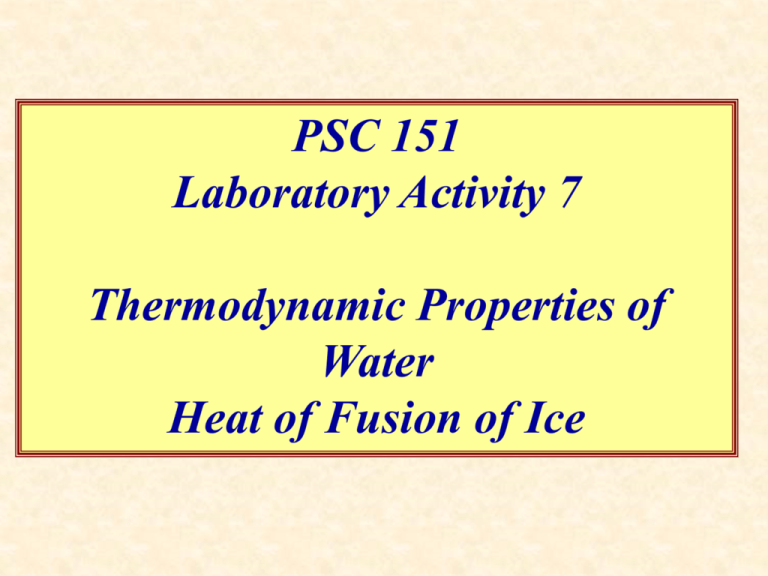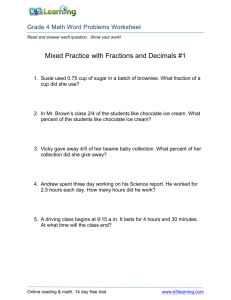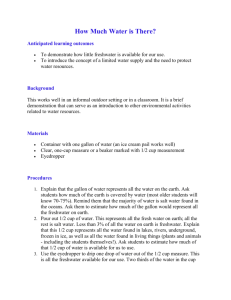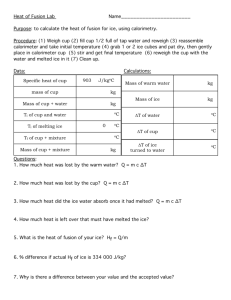Heat_of_Fusion_html
advertisement

PSC 151 Laboratory Activity 7 Thermodynamic Properties of Water Thermodynamic Properties of Water Heat of Fusion of Ice What causes the temperatures of two objects placed in thermal contact to change? TH TC TC TH Something must move from the high temperature object to the low temperature object. Is it matter or energy? If it is matter the mass of the high temperature object would decrease while the mass of the low temperature object would increase. This is not observed. It must be energy flowing between the two objects that causes a change in their temperatures. The energy flowing between the two objects must be on the microscopic level because we can not see it. Energy Review Kinetic energy, KE-the macroscopic energy an object has due to its motion, measured in Joules, J. Gravitational potential energy energy, GPE-the macroscopic energy an object has due to its position , measured in Joules, J. Total mechanical energy, E-the sum of an object’s kinetic and potential energies , measured in Joules, J. Work, W-the process by which the total mechanical energy can be changed , measured in Joules, J. Work and the Related Changes in Macroscopic Energy Work,W Change in Mechanical Energy E Change in Kinetic Energy E and/or Change in Potential Energy GPE All macroscopic objects are composed of microscopic objects: atoms and molecules Macroscopic Object Atoms and Molecules These atoms and molecules are moving so they have a microscopic kinetic energy. These atoms and molecules are subject to conservative forces (gravitational and electrical) so they have a microscopic potential energy. The sum of these microscopic kinetic and potential energies is called Thermal Energy, U. When two objects with different temperatures are placed in thermal contact, thermal energy flows from the higher temperature object to the lower temperature object until thermal equilibrium is reached. The thermal energy that flows between two objects because of a difference in temperature is called heat, Q. Since heat is a form of energy it is measured in Joules, J. For historical reasons another unit of thermal energy or heat is sometimes used: calorie, cal or kilocalorie, kcal. Conversion Factor 1kcal = 4186J When work is done on or by an object there is a change in the object’s kinetic energy or its gravitational potential energy or both. The change in kinetic energy is perceived as a change in object’s velocity. The change in gravitational potential energy is perceived as a change in object’s position (height above the reference level). When heat flows into or out of an object there is a change in the object’s thermal energy. How is the change in the thermal energy of an object perceived? A change in thermal energy is perceived as a change in the object’s temperature or phase (solid, liquid, or gas). It has been observed that the change in temperature and the change in phase never occur at the same time. When the temperature is changing the phase remains constant and when the phase is changing the temperature remains constant. Heat, Q Change in Temperature T Phase Constant Change in Thermal Energy U or Change in Phase T=0 What variables determine the magnitude of the change in temperature? Q Q Water Water More heat results in a larger change in temperature: change in temperature is directly proportional to the amount of heat. T Q Q 1kg Water Q 2kg Water When the same quantity of heat flows into (or out of) a larger mass the change in temperature is less.The change in temperature is inversely proportional to the mass. T 1 m Q 1kg Water Q 1kg Alcohol When the same quantity of heat flows into (or out of) equal masses of different substances the change in temperature is different. The change in temperature depends on the specific heat, c of the substance. The specific heat of a substance is the amount of heat required to change the temperature of 1kg of the substance by 1C°. Units : J or kcal kg C kg C Q 1kg Water c water Q 1 kcal kg C 1kg Alcohol c alcohol 0.6 kcal kg C The substance with the higher specific heat experiences a smaller change in temperature. The change in temperature is inversely proportional to the specific heat. 1 T c Combing All of the Proportions 1 1 T Q, , m c Q T mc Q mcT Heat flow that results in a phase change can not be described by the equation above since during a phase change the temperature remains constant…T=0. It has been observed that phase changes can only occur at certain temperatures which depend on the particular substance. Temperature increases Q Temperature remains constant 0°C 0°C -20°C -20°C Ice @ -20°C Q Ice @ 0°C Ice begins melting 0°C is the melting (or freezing) point of water. As more heat is added the temperature will remain constant as more ice melts. Once all of the ice has melted the addition of more heat will result in an increase in the temperature of the water. 100°C Temperature increases Q Temperature remains constant 100°C 0°C 0°C -20°C -20°C Water @ 0°C Q Water @ 100°C Water begins boiling 100°C is the boiling point of water. As more heat is added the temperature will remain constant as more water converts to steam. Once all of the water has converted to steam the addition of more heat will result in an increase in the temperature of the steam. What determines how much ice melts or water converts to steam? Q 0°C 0°C -20°C -20°C Ice @ 0°C Q Ice @ 0°C More heat results in a larger mass of ice melting. The mass of ice melted is directly proportional to the quantity of heat. m Q 0°C -114°C Q 1kg ice @ 0°C Q 1kg solid alcohol @ -114°C When the same quantity of heat flows into (or out of) equal masses of the solid phase of different substances, each at its melting point, different masses will melt. The mass that melts depends on the latent heat of fusion, Qf of the substance. The latent heat of fusion of a substance is the quantity of heat required to change 1kg of the solid phase of the substance, at its melting point, to 1kg of liquid at the same temperature. J kcal Units : or kg kg Q f,water 80 kcal kg Q f,alcohol 0°C Q 1kg ice @ 0°C Q -114°C 25 kcal kg 1kg solid alcohol @ -114°C The substance with the greater heat of fusion experiences less melting. The mass melted is inversely proportional to the heat of fusion m 1 Qf Combing All of the Proportions 1 m Q, Qf Q m Qf Q mQ f solid liquid There is a similar equation describing the phase change between liquid and gas. Q mQ v liquid gas Qv is the latent heat of vaporization, the quantity of heat required to change 1kg of the liquid phase of the substance, at its boiling point, to 1kg of gas at the same temperature. J kcal Units : or kg kg Heat, Q Change in Temperature T Phase Constant Change in Thermal Energy U Q mcT Change in Phase T=0 Q mQ f solid liquid Q mQ v liquid gas Summary of Thermodynamic Properties and Relationships I) Phase Change Temperatures- °C, K, °F A) Melting / Freezing Point, Tf B) Boiling Point, Tb II) Specific Heat - J , kcal kg C kg C A) Solid Phase, csolid B) Liquid Phase, cliquid C) Gas (vapor) Phase, cgas 1. cp , constant pressure 2. cv , constant volume III) Latent Heat - J , kcal kg kg A) Latent Heat of Fusion, Qf B) Latent Heat of Vaporization, Qv IV) Thermodynamic Relationships A) Change in Temperature, Q = mcT B) Change in Phase (solid liquid), Q = mQf C) Change in Phase (liquid gas), Q = mQv Example: Water Tf = 0°C, 273K, 32°F Tb = 100°C, 373K, 212°F c ice 2093 J , 0.5 kcal kg C kg C J , 1.0 kcal kg C kg C 2020 J , 0.483 kcal kg C kg C c water 4186 c p,steam c v,steam 1520 J , 0.363 kcal kg C kg C Q f 3.34 10 5 J , 80.0 kcal kg kg Q v 2.26 106 J , 540.0 kcal kg kg Graphical Representation of Heat Flow, Temperature Change, and Final Tfinal Phase Change Boiling Point Q mQv Temperature Tb Q mc vaporT Temperature T, °C Step #1 Raise the temperature to the melting point Tf Melting Point Tinitial Step #2 Melt all of the solid Step #3 Raise temperature of liquid to boiling point Step #4 Convert the liquid to gas Step #5 Raise the temperature of the gas to the final temperature Q mc liquidT Q mQ f Q mcsolidT Initial Temperature Heat flow w/ Temperature Change Heat flow w/ Phase Change Heat Flow Q, kcal Calorimetry When heat transfer between two systems occurs inside of an insulated environment, no heat is lost to the external environment and no heat enters the systems from the outside. In this case we can say that the heat lost by the high temperature system equals the heat gained by the low temperature system. Further, we can recognize when the two systems have reached thermal equilibrium by noting when the temperature of the combined system remains constant. Qlost Qgained Suppose we place a known mass of tap water (mw) into an insulated calorimeter cup and measuring its initial temperature (Ti). Then a small amount of ice (assumed to be at 0°C) is added to the cup, and when thermal equilibrium is reached, the final temperature (Tf) is measured. Heat will flow from the tap water into the ice. Temperature, °C The temperature of the tap water will decrease while the ice will first melt and then the temperature of the ice water will increase until a final common temperature is reached. The mass of ice (mi) added can be determined by measuring the increase in the amount of water in the cup. water @ T Ti tap water cooling to final temperature Tf 0C ice melting ice water warming to final temperature ice @ 0°C Qgained Qlost Heat i Qlost (tap water) = mw c w Tw Tw Ti Tf Qgained (ice) = mi Qf Qgained (ice water) = m ic w Tiw Tiw Tf 0 Tf Qlost Qgained mw c w Tw mi Qf mic w Tiw mi Qf m w c w Tw m ic w Tiw m w c w Tw m i c w Tiw Qf mi Procedure Step 1. Measure the mass of the empty calorimeter cup…Record in Data Table 1. Step 2. Place about 150ml of tap water in the calorimeter cup and measure the mass…Record in Data Table 1. Step 3. Insert the temperature probe, and measure the initial temperature (Ti) of the tap water …Record in Data Table 1. Step 4. Remove the temperature probe. Place 3-4 pieces of ice in the calorimeter cup and quickly replace the lid. Step 5. Place the Styrofoam cover on the cup and insert the temperature probe. Wait until thermal equilibrium is reached (temperature reading remains constant). This will ensure that all of the ice has melted and all of the water has reached the common final temperature. Record the final equilibrium temperature in Data Table 1. Step 6. Remove the temperature probe and lid. Measure the final mass and record in Data Table 1. Data Table 1 Mass of Calorimeter Cup, g Mass of Calorimeter Cup & Tap Water-m w, g Mass of Tap Water-m w, g Mass of Tap Water-mw, kg Initial Temperature of Tap Water-T i , °C Add ice and wait for thermal equilibrium. Final Equilibrium Temperature-T f , °C Final Mass of Calorimeter Cup & Water, g Mass of Ice Added to Calorimeter Cup-m i , g Mass of Ice Added to Calorimeter Cup-mi , kg mw Ti Tf mi Supprt Ring Outer Cup Inner Cup Opening for Stirrer Outer Cup Inner Cup Opening for Temperature Probe Support Ring Measure mass of cup. Place about 150ml of water in the cup. Measure mass of cup and water, subtract the mass of the cup to determine the mass of tap water - mw, kg. Insert the CBL temperature probe. Measure initial temperature of tap water -Ti, °C. 23.8°C Inner Cup Place the inner cup inside the outer cup. Add 3-4 pieces of ice to the water in the cup. Quickly place the top on the calorimeter cup and reinsert the temperature probe. Wait for thermal equilibrium to be reached. Temperature Constant Measure final equilibrium temperature -Tf, °C Measure final mass of water, subtract initial mass to determine mass of ice added - mi, kg 18.5°C Step 7. Calculate the heat of fusion of ice. m w c w Tw m i c w Tiw Qf mi Tw Ti Tf Tiw Tf 0 Tf mw c w Ti Tf mi c w Tf Qf mi mw c w Ti Tf mi c w Tf Qf mi m i Qf m w c w Tf Ti m i c w Tf mi Qf mi c w Tf m w c w Tf Ti mi Qf c wTf mw c w Tf Ti m w c w Tf Ti mi Q f c w Tf mw c w Ti Tf mi c w Tf Qf mi mi Qf m w c wTi mw c w Tf mi c w Tf mw c w Tf mi c w Tf m w c wTi mi Qf mw mi c wTf mw c w Ti mi Q f m w c w Ti m iQ f Tf m w m i c w







